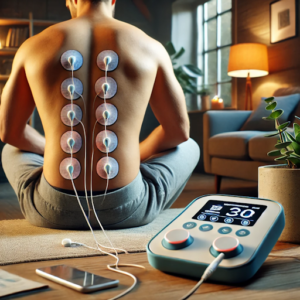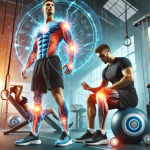Optimize Back Pain Relief with Electrotherapy Techniques
Back pain is a pervasive issue impacting millions of individuals globally, transcending various demographics such as age, gender, and lifestyle factors. It can manifest in diverse forms, ranging from sharp discomfort that lasts a few days to chronic pain that endures for months or even years. Often, back pain arises from a combination of physical, psychological, and environmental influences, making it a complex condition to address effectively.
Common causes of back pain include muscle strain, herniated discs, arthritis, and poor posture. The variability in how individuals experience back pain complicates the diagnosis and treatment process. While some may find the discomfort tolerable, others could be severely debilitated, necessitating a comprehensive approach from healthcare professionals to restore function and alleviate pain.
Moreover, chronic back pain can significantly affect emotional well-being, often leading to anxiety, depression, and social isolation. The economic implications are also substantial, as back pain is among the leading causes of disability and reduced productivity in the workplace, impacting both personal and professional lives.
Understanding the underlying causes of back pain is crucial for developing effective treatment strategies. One such strategy is electrotherapy, which has gained recognition for its ability to relieve pain and promote recovery in a non-invasive manner.
Essential Insights on Back Pain and Electrotherapy
- Back pain can arise from various factors, including poor posture, muscle strain, and injury, significantly affecting daily life.
- Electrotherapy is a non-invasive technique that utilizes electrical energy to manage pain and facilitate healing.
- This method offers multiple benefits, such as pain relief, muscle relaxation, enhanced circulation, and reduced inflammation.
- Different electrotherapy modalities, such as TENS (Transcutaneous Electrical Nerve Stimulation) and EMS (Electrical Muscle Stimulation), can effectively alleviate back pain.
- It is vital to adhere to healthcare professional guidance when using electrotherapy and to avoid using it near the heart or on broken skin.
 Exploring the Benefits of Electrotherapy for Back Pain Relief
Exploring the Benefits of Electrotherapy for Back Pain Relief
Electrotherapy encompasses a variety of techniques that utilize electrical energy to treat conditions such as back pain. This therapeutic approach has evolved significantly, incorporating advanced technologies to provide effective pain relief and facilitate the healing process. By delivering precise electrical impulses, electrotherapy targets specific areas of discomfort, stimulating nerves and muscles effectively.
Unlike traditional medications, which may lead to unwanted side effects or dependency, electrotherapy is a non-invasive treatment option that can help manage back pain. As research continues to unfold, the numerous benefits of electrotherapy are becoming more widely recognized, leading to its integration into comprehensive pain management plans employed by healthcare providers.
One of the most notable advantages of electrotherapy is its capacity to provide immediate pain relief. By interrupting pain signals with electrical impulses directed at the affected area, electrotherapy effectively reduces discomfort.
Moreover, this therapeutic modality promotes the release of endorphins, the body’s natural pain relievers, which enhances its overall effectiveness. Additionally, electrotherapy improves blood circulation and reduces inflammation, supporting the healing process. This combination of immediate relief and long-term benefits makes electrotherapy an invaluable tool for those struggling with back pain.
Diverse Electrotherapy Methods for Targeted Back Pain Management
Electrotherapy encompasses various methods, each tailored to address different aspects of back pain management. TENS (Transcutaneous Electrical Nerve Stimulation) is a widely recognized technique that delivers low-voltage electrical currents to alleviate pain. Its portability and user-friendly nature make it particularly suitable for home treatment, allowing individuals to manage their pain conveniently.
IFC (Interferential Current Therapy) utilizes medium-frequency electrical currents to penetrate deeper tissues and effectively address musculoskeletal issues. This technique is especially beneficial for individuals dealing with persistent pain that originates from deeper structures within the body.
In addition, EMS (Electrical Muscle Stimulation) and microcurrent therapy are gaining traction for their ability to stimulate muscle contractions and support tissue repair. These modalities not only help alleviate pain but also enhance muscle function, promoting overall recovery.
 Guidelines for Effectively Using Electrotherapy to Manage Back Pain
Guidelines for Effectively Using Electrotherapy to Manage Back Pain
Following specific guidelines is crucial to ensuring the safety and effectiveness of electrotherapy. Patients should always consult with a healthcare provider to determine the most appropriate electrotherapy options based on their individual needs and conditions. Once a treatment plan is established, therapy can be administered in clinical settings or through portable devices at home.
For those using electrotherapy at home, it is essential to adhere to the manufacturer’s instructions regarding electrode placement, intensity, and session duration. A typical session usually lasts between 20 and 60 minutes, and consistency is vital, as regular treatments yield cumulative benefits over time. Maintaining open communication with a healthcare provider is essential for tracking progress and making necessary adjustments to the treatment plan.
Important Precautions and Considerations for Electrotherapy Use
While electrotherapy is generally regarded as safe, certain precautions should be taken to avoid potential complications. Individuals with heart disease, epilepsy, or implanted devices like pacemakers should consult a healthcare provider before using electrotherapy to ensure their safety. Pregnant women are also advised to avoid electrotherapy in areas near the abdomen or lower back, as it could potentially affect the developing fetus.
It is crucial to avoid placing electrodes on open wounds or infected areas to prevent further complications. Patients should monitor their bodies for any adverse reactions during treatment. If they experience increased pain or skin irritation, it is important to stop the therapy immediately and consult with a healthcare professional for further guidance.
 Enhancing Back Pain Management: Integrating Electrotherapy with Holistic Techniques
Enhancing Back Pain Management: Integrating Electrotherapy with Holistic Techniques
Integrating electrotherapy with other treatment modalities can significantly enhance the management of back pain. A holistic approach often yields better results compared to relying on a single therapy. For instance, combining electrotherapy with physical therapy can not only strengthen muscles but also improve flexibility while addressing underlying musculoskeletal problems.
Making ergonomic adjustments in your workspace or home environment can further amplify the benefits of electrotherapy by reducing strain on the back. Additionally, incorporating stress-reducing practices such as yoga, meditation, or mindfulness can alleviate pain perception by promoting relaxation and enhancing overall well-being.
Frequently Asked Questions About Electrotherapy for Back Pain Management
What is electrotherapy, and how does it work for back pain relief?
Electrotherapy employs electrical stimulation to manage and alleviate back pain through various methods, including TENS and EMS, providing both pain relief and muscle stimulation.
How might electrotherapy alleviate my back pain effectively?
Electrotherapy stimulates nerves and muscles to enhance blood flow, promote healing, block pain signals, and trigger the production of endorphins, which are the body’s natural painkillers.
Is electrotherapy considered a safe option for managing back pain?
Electrotherapy is generally safe when administered under the guidance of a trained healthcare provider. Always adhere to recommended protocols and avoid applying the device near sensitive areas like the head or heart.
What mechanisms does electrotherapy utilize to relieve back pain?
Electrotherapy alleviates pain, reduces muscle spasms, and enhances flexibility, offering a non-invasive and drug-free alternative for effective back pain management.
Who can benefit from electrotherapy in managing back pain?
Electrotherapy may be advantageous for individuals experiencing conditions such as muscle strains, arthritis, sciatica, or herniated discs, particularly as part of a comprehensive pain management strategy.
Are there specific situations where electrotherapy isn’t recommended?
Electrotherapy is not advisable for individuals with pacemakers, epilepsy, or heart conditions. Always consult a healthcare provider before beginning treatment.
Brought To You By: Back Pain Therapy
The article: Managing Back Pain with Electrotherapy appeared first on https://mcrtherapies.co.uk.
The article: Managing Back Pain with Electrotherapy appeared first on https://mcrtherapies.com.
The article: Managing Back Pain with Electrotherapy was found on https://limitsofstrategy.com.
The Article Electrotherapy: A Powerful Solution for Back Pain Management First Appeared ON
: https://ad4sc.com


It’s fascinating to see how electrotherapy techniques are gaining recognition in managing back pain, especially given the multi-faceted nature of this issue. I’ve personally experienced how chronic pain can affect not just physical mobility but also emotional well-being.
It’s true how intricate the journey with back pain can be. The interplay between physical discomfort and emotional well-being is often overlooked, isn’t it? I’ve seen how chronic pain can reshape daily life—not just affecting routine activities but also impacting mental health and relationships.
You bring up such a crucial point about the interplay between physical discomfort and emotional well-being. It’s interesting how often our society tends to focus on just the physical aspect when dealing with chronic pain. I remember experiencing some back pain a few years ago, and it was eye-opening to see how it affected not just my daily activities but also my mood and interactions with others.
It really is fascinating how intertwined physical discomfort and emotional well-being are. I’ve noticed that the journey with chronic pain often extends beyond the individual, affecting family dynamics and friendships too. It’s like a ripple effect—when you’re in pain, your mood shifts, and suddenly those small interactions can feel overwhelming or strained.
You bring up such a crucial point about how the journey with chronic pain doesn’t just affect those who experience it firsthand; it really does create a ripple effect that touches everyone around them. I’ve seen it in my own life as well, where a friend’s chronic illness changed not just their daily mood but also how our group interacted.
You’re right to highlight that ripple effect. Chronic pain doesn’t isolate itself; it seeps into the fabric of relationships and community dynamics. When someone close to us is struggling, their challenges can subtly shift how we interact and communicate. It’s like having to navigate a new terrain where the signs are different, and sometimes it’s unclear how to proceed.
You’ve hit on something many people overlook—the way chronic pain isn’t just a personal battle, but a shared experience that changes relationships. It’s not always easy to understand if you haven’t been in those shoes yourself.
It’s so true how the journey with chronic pain weaves itself into the fabric of our relationships. When you’re in pain, every mood shift can influence not just how you feel, but how you interact with those closest to you. I’ve experienced that ripple effect personally; it can be challenging to reconcile your own struggles while trying to maintain a sense of normalcy with friends and family.
You bring up an important point about the relationship between chronic pain and emotional well-being. The acknowledgment that pain isn’t just a physical issue is more pertinent than ever, especially as we’re seeing a shift towards holistic approaches in healthcare. Many people think about pain mainly in terms of its physical manifestations, such as limited mobility or discomfort. However, the emotional and psychological aspects often get overshadowed, even though they significantly impact daily life.
Your insights on back pain resonate deeply with many of us navigating the complexities of this condition. Having experienced back discomfort myself, I can relate to the multifaceted nature of the struggle—how it intertwines with our physical capabilities and mental health.
It’s fascinating to read about the complexities surrounding back pain and how electrotherapy techniques can play a role in alleviating such a multifaceted issue. Experiencing back pain myself in the past, I found it to be a real game-changer in terms of how I approached my overall health and well-being. Initially, I viewed it solely as a physical problem, not fully appreciating how intertwined it is with psychological and lifestyle factors.
It’s really interesting to hear about your journey with back pain and how it shifted your perspective on health. Many people find themselves in a similar situation, thinking of pain primarily as a physical ailment without recognizing the deeper connections to mental and emotional well-being.
Your exploration of back pain and its complexities really resonates with me—it’s a topic that often goes under-discussed despite its profound impact on daily life. I’ve been grappling with chronic back pain for several years now, and it’s fascinating yet frustrating how varied the reasons and remedies can be.
It’s great to hear that this topic resonates with you. Chronic back pain is more common than many people realize, yet it often feels like we’re navigating it alone. The reasons for back pain can indeed feel like a labyrinth, and finding effective remedies can turn into a frustrating journey.
This blog post touches on such an important topic that many of us have personal experience with. Back pain can indeed feel like a solitary struggle, and it’s fascinating how complex it is, as you mentioned. I’ve dealt with occasional back pain myself, often attributed to long hours spent at a desk and the creeping poor posture that comes with it.
It’s interesting to hear you share your own experience with back pain, especially in relation to the long hours at a desk. So many of us are navigating that same struggle today, and it really highlights how our lifestyles can impact our everyday well-being. The connection between poor posture and back pain is something I’ve looked into a lot, especially with the rise of remote work.
Your analysis of back pain’s multifaceted nature is quite insightful. I’ve personally witnessed how debilitating back pain can be, both in my own experience and through observing friends and family members. The interplay between physical and psychological factors is particularly noteworthy; I’ve found that anxiety can exacerbate the perception of pain, creating a vicious cycle that’s hard to break.
It’s true that the interplay between physical and psychological factors in back pain can be quite overwhelming. I’ve seen that same pattern where anxiety tends to amplify pain perception, making just getting through the day feel like a monumental task. It’s fascinating how our minds can influence our physical state so profoundly.
You’ve touched on an important point about the interplay between physical and psychological factors. Many people don’t realize how deeply intertwined they are. Anxiety can reshape the way we perceive pain, making it feel more intense and harder to manage. The brain’s response to pain isn’t just about what’s happening physically; our emotional state plays a massive role too.
Your exploration of the complexities surrounding back pain is incredibly thought-provoking. It’s fascinating how back pain can touch nearly anyone’s life, yet its impact can vary so widely between individuals. Personally, I can relate to this based on my journey with chronic back pain over several years. Like many, I experienced an acute episode that escalated into a chronic condition due to a combination of factors — work-related posture, lifestyle choices, and stress.
It’s eye-opening how many layers there are to back pain, and your experience really highlights that. The way you describe your journey—how a single acute episode evolved into chronic pain—resonates with so many people. It’s interesting how various factors like posture at work, lifestyle habits, and stress interplay to create a complex web of challenges.